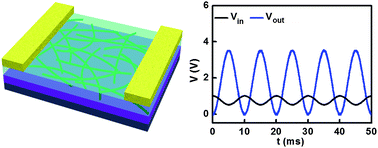High performance amorphous ZnMgO/carbon nanotube composite thin-film transistors with a tunable threshold voltage†
Abstract
Here we report the fabrication and characterization of high mobility amorphous ZnMgO/

Maintenance work is planned for Wednesday 1st May 2024 from 9:00am to 11:00am (BST).
During this time, the performance of our website may be affected - searches may run slowly and some pages may be temporarily unavailable. If this happens, please try refreshing your web browser or try waiting two to three minutes before trying again.
We apologise for any inconvenience this might cause and thank you for your patience.
* Corresponding authors
a
Department of Physics and Key Laboratory of Artificial Micro- and Nano-structures of Ministry of Education, Wuhan University, Wuhan 430072, China
E-mail:
liaolei@whu.edu.cn
b Department of Electronic & Computer Engineering, Hong Kong University of Science & Technology, Hong Kong SAR, China
c Center for Applied Chemical Research, Frontier Institute of Science and Technology, Xi'an Jiaotong University, Xi'an, China
d Department of Chemistry and Biochemistry, University of California, Los Angeles, California 90095, USA
Here we report the fabrication and characterization of high mobility amorphous ZnMgO/

 Please wait while we load your content...
Something went wrong. Try again?
Please wait while we load your content...
Something went wrong. Try again?
X. Liu, W. Liu, X. Xiao, C. Wang, Z. Fan, Y. Qu, B. Cai, S. Guo, J. Li, C. Jiang, X. Duan and L. Liao, Nanoscale, 2013, 5, 2830 DOI: 10.1039/C3NR34222K
To request permission to reproduce material from this article, please go to the Copyright Clearance Center request page.
If you are an author contributing to an RSC publication, you do not need to request permission provided correct acknowledgement is given.
If you are the author of this article, you do not need to request permission to reproduce figures and diagrams provided correct acknowledgement is given. If you want to reproduce the whole article in a third-party publication (excluding your thesis/dissertation for which permission is not required) please go to the Copyright Clearance Center request page.
Read more about how to correctly acknowledge RSC content.
 Fetching data from CrossRef.
Fetching data from CrossRef.
This may take some time to load.
Loading related content
